Qvevri & Qvevri Wine Museum
ქვევრისა და ქვევრის ღვინის მუზეუმი
by
Terry Sullivan
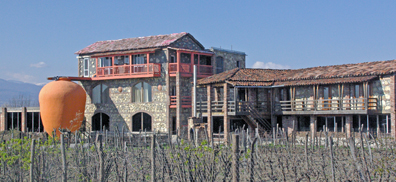 Summary: How are qvevris made? How do winemakers make and age wine in qvevris? These are two of the many questions about qvevris that visitors can find answers to while ambling through the exhibits in the Qvevri and Qvevri Wine Museum. This is the first museum in the world dedicated to this ancient craft that is now a part of the UNESCO World Heritage list.
Summary: How are qvevris made? How do winemakers make and age wine in qvevris? These are two of the many questions about qvevris that visitors can find answers to while ambling through the exhibits in the Qvevri and Qvevri Wine Museum. This is the first museum in the world dedicated to this ancient craft that is now a part of the UNESCO World Heritage list.
In April 2014 we returned to Twins Wine Cellar in Napareuli to open our qvevri-made wine we began in September 2013. At the time of our September visit, we toured the beginning stages of a qvevri and qvevri wine museum. During our most recent visit, the museum was finished and just opened to the public. It is a destination that visitors to Georgia should put on their itinerary.
You will notice Twins Wine Cellar in Napareuli long before you arrive at the winery. The world’s largest qvevri, two stories high, stands tall next to the entrance to the Qvevri and Qvevri Wine Museum. You can take a short stairway and enter the spacious qvevri. While inside the qvevri, consider washing the sides of the qvevri, at least those large enough to climb into. Small capacity qvevris may be more challenging to clean. Also think about the different vessels used to make wine: oak, stone, cement, stainless steel, fiberglass and plastic. The qvevri, made from earth and fired to the orange color has been a wine making vessel for thousands of years. On a timeline of winemaking vessels, stainless steel tanks are only a dot.
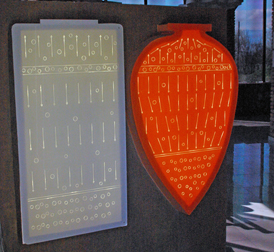 Walking into the museum, you will notice numerous displays and exhibits that explain the process of making qvevris, the winemaking process inside a qvevri and the steps used to make wine in a qvevri. One display compares the fermentation process inside a stainless steel tank and qvevri. The less technical displays are the dioramas, where three dimensional figures show the process of making qvevris and qvevri winemaking.
Walking into the museum, you will notice numerous displays and exhibits that explain the process of making qvevris, the winemaking process inside a qvevri and the steps used to make wine in a qvevri. One display compares the fermentation process inside a stainless steel tank and qvevri. The less technical displays are the dioramas, where three dimensional figures show the process of making qvevris and qvevri winemaking.
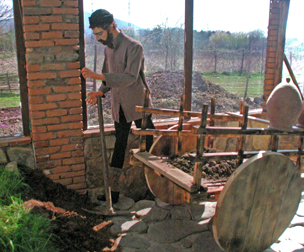 The first of these dioramas shows a qvevri maker with a wagon obtaining the clay. Just outside the museum window there is a pile of red clay. This display also shows red clay and some of the red clay was put into the wagon. The next 3D display shows a qvevri maker forming the qvevri by adding a clay coil to the top. In this diorama there is a larger qvevri as well as the small starting bases of qvevris.
The first of these dioramas shows a qvevri maker with a wagon obtaining the clay. Just outside the museum window there is a pile of red clay. This display also shows red clay and some of the red clay was put into the wagon. The next 3D display shows a qvevri maker forming the qvevri by adding a clay coil to the top. In this diorama there is a larger qvevri as well as the small starting bases of qvevris.
After a qvevri is formed and dried they are carefully moved into a walk-in oven where they are fired. The next display shows a large oven with qvevris inside. During our first visit, the oven was in the process of being built (first photo below). A part of the temporary brick wall covering the entrance was left open so you could see the qvevris inside. A display of a fire is viewable at the bottom. When qvevris are fired the temporary brick wall covers the opening, except for a small opening at the bottom where wood is added to fuel the fire.
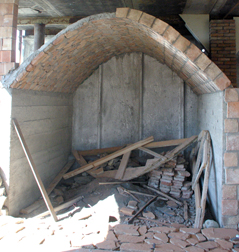
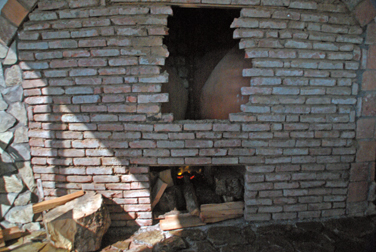
Moving on there are two dioramas that show what is done to a qvevri after firing. The first shows the application of a lime cement to the outside of a qvevri. This may be done by the qvevri maker. It may also be done by the winemaker. The cement coating protects the qvevri from roots. We heard that it provides some protection from earthquakes. The last display in this area shows men in the process of burying qvevri in the ground. From this room we entered another room.
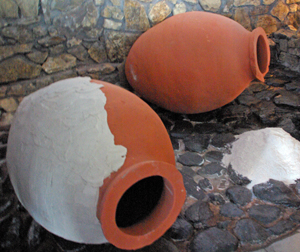
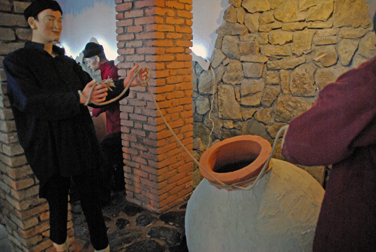
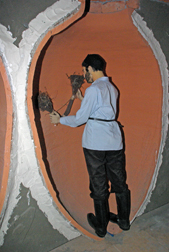 This second area of the museum is on two floors and several of the displays are seen from both floors. Visitors can get an idea of a marani at the top and side-views of the qvevris buried underground. Now the displays show qvevris that are in a winery and the steps to maintain a qvevri are shown. A diorama shows a worker cleaning the inside of a qvevri with a cherry bark brush. The side of the qvevri is cut away for viewing. Another display also has a cut-away qvevri. A worker is inside the qvevri cleaning the sides of the winemaking vessel.
This second area of the museum is on two floors and several of the displays are seen from both floors. Visitors can get an idea of a marani at the top and side-views of the qvevris buried underground. Now the displays show qvevris that are in a winery and the steps to maintain a qvevri are shown. A diorama shows a worker cleaning the inside of a qvevri with a cherry bark brush. The side of the qvevri is cut away for viewing. Another display also has a cut-away qvevri. A worker is inside the qvevri cleaning the sides of the winemaking vessel.
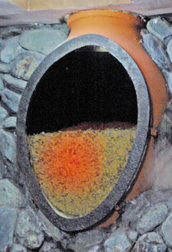 There are a number of additional displays. One shows the stomping of grapes in a wood press. The juice then runs into a qvevri. On a lower level there is an excellent display of real qvevris that have been cut away and a viewing glass inserted. You can actually observe wine being made and aged. Of interest was the yeast, seeds and skins that make up the chacha and how it settles in the qvevri. These cut-away qvevris can be used to understand the process of how a qvevri works.
There are a number of additional displays. One shows the stomping of grapes in a wood press. The juice then runs into a qvevri. On a lower level there is an excellent display of real qvevris that have been cut away and a viewing glass inserted. You can actually observe wine being made and aged. Of interest was the yeast, seeds and skins that make up the chacha and how it settles in the qvevri. These cut-away qvevris can be used to understand the process of how a qvevri works.
The Qvevri and Qvevri Wine Museum at Twins Wine Cellar in Napareuli is a must for wine enthusiasts and curious travelers in the Kakheti region of Georgia. If possible, try to make this visit at the beginning of your wine journey. It will greatly help as you view maranis and taste traditional Georgian wines.
Qvevri and Qvevri Wine Museum
at Twins Wine Cellar in Napareuli
Napareuli, Kakheti, Georgia
Article Written April, 2014
